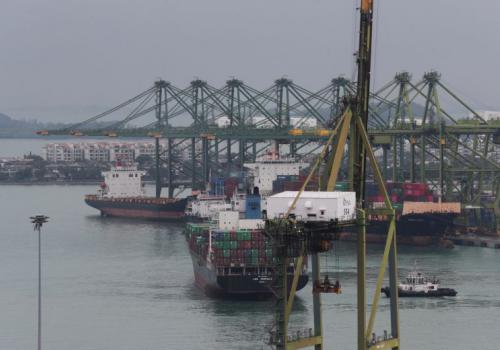Singapore's non-oil domestic exports (Nodx) continued to grow though at a slower pace in July, driven mainly by non-electronic goods such as non-monetary gold, specialised machinery and pharmaceuticals.
Nodx rose 6 per cent year on year last month after a revised 13.9 per cent expansion in June and a 4.6 per cent drop in May, said Enterprise Singapore in a statement on Monday (Aug 17).
The gain in July was higher than the 4.4 per cent jump predicted by economists in a Bloomberg survey. Nodx has now increased in five out of the seven months of this year, a robust performance when compared with only one month of gain in 2019.
On a month-on-month seasonally adjusted basis, Nodx rose 1.2 per cent in July, after the previous month's 1.4 per cent decline. The growth in non-electronic domestic exports outweighed the decline in electronics.
Nodx growth slowed down on a three-month moving average year on year basis as well. The increase averaged 4.6 per cent in July compared to the 5.9 per cent gain in June.
On a year-on-year basis, non-electronic Nodx increased by 6.9 per cent last month, following the 11.7 per cent expansion in the previous month. Contributing the most to July export gains, non-monetary gold shipments surged 227.9 per cent, specialised machinery rose 60.1 per cent and pharmaceuticals were up 15.5 per cent.
The July gain in non-monetary gold shipments was aided by a low base in July 2019 when gold exports declined 3.1 per cent. But there was also a jump in demand this year for physical gold as a safe-haven asset amid global economic uncertainty and the coronavirus pandemic. Fitch Solutions last week revised up its 2020 gold price forecast to US$1,850 per ounce compared with US$1,680 previously after market prices breached an all-time high of US$1,900 in July.
ESG data showed specialised machinery exports fell by 31 per cent in July 2019. The typically volatile pharmaceutical exports were also down 33 per cent in July 2019.
Electronic Nodx grew by 2.8 per cent in July, less than the low-base driven expansion of 22.2 per cent in June. Disk media products, telecommunications equipment and Integrated circuit shipments increased by 23, 18.2 and 1.5 per cent respectively.
Explaining the low base for electroncis, ESG said that electronic Nodx fell 32 per cent to $2.6 billion in June 2019, the lowest monthly level in 2019 and against an average of $3.1 billion. Domestic exports of disk media products also declined by 25 per cent in July 2019 amid the global electronic downcycle.
Electronics, pharmaceutcials and chemicals accounted for 61 per cent of Singapore’s $14 billion July Nodx.
Lee Ju Ye, economist at Maybank Kim Eng Securities said; “We reiterate our positive outlook on exports, as Singapore rides on resilient demand for electronics, which is 22 per cent of Nodx, and pharma, which is 10 per cent of the total.”
She said manufacturing will likely escape recession as exports and regional trade recovers through the year. “The improving performance of regional export powerhouses in July, including China, Vietnam, South Korea and Taiwan, signals an encouraging start to the third quarter,” she noted.
Nodx to the top markets as a whole grew in July, though exports to Indonesia, Thailand, Hong Kong, China and the EU 27 declined.
The markets that accounted for most of the growth in Nodx were led by the United States (+98.7 per cent), South Korea (+56.3 per cent) and Taiwan (+18.7 per cent).
The Government last week raised Singapore’s 2020 trade forecasts with non-oil domestic exports (Nodx) now predicted to grow by 3 to 5 per cent year on year, compared with an earlier forecast for a 1 to 4 per cent fall.
Total merchandise trade, meanwhile, is tipped to shrink at a slower pace of 8 to 10 per cent, from the 9 to 12 per cent slump seen in May.
Trade promotion agency Enterprise Singapore (ESG) said on Tuesday (Aug 11) its upgraded forecasts came amid the better-than-expected performance for specific products, such as non-monetary gold, pharmaceuticals and electronics.
But it cautioned that the global economic outlook remains uncertain, though global trade is unlikely to reach the worst-case scenario earlier projected by the World Trade Organisation.
